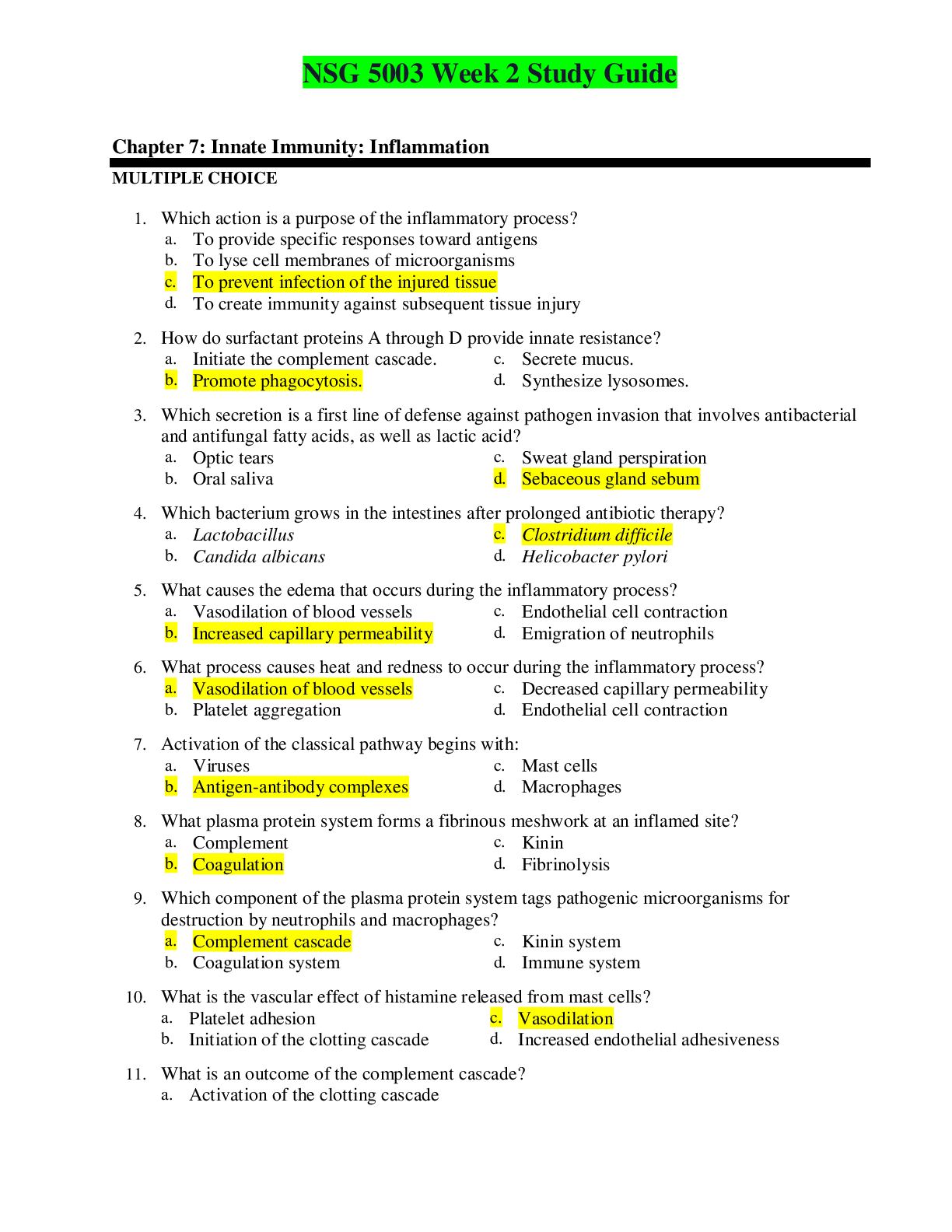*NURSING > STUDY GUIDE > NURS 340 Exam 2 - Week 2 Study Guide Latest 2022/2023,100% CORRECT (All)
NURS 340 Exam 2 - Week 2 Study Guide Latest 2022/2023,100% CORRECT
Document Content and Description Below
NURS 340 Exam 2 - Week 2 Study Guide Latest 2022/2023 Chapter 21 Vulnerability and Vulnerable Populations: An Overview Introduction • People have different genetic compositions, social and en... vironmental resources, skills, support systems, and access to health services • People with lower incomes and less education @ higher risk for health problems • A goal in the US is to eliminate health disparities by expanding access to health care for vulnerable or at-risk populations • Usually have 1 or more physical or mental health disparity Vulnerability: Definition, Risk Factors, and Health Disparities • Vulnerable populations are at a greater risk for poor health status and health care access o Groups and communities at a higher risk of health as a result of barriers they experience of social, economic, political, environmental resources and a physical disability o They don’t know how to access the resources they need o Different models to study external and internal factors: ▪ Natural history of disease model: certain aspects of physiology and environment including personal habits, social environment, physical environment make it more likely for a person to develop a health issue ▪ Web of causation model: interaction of multiple variables that creates the powerful combination of factors that predispose a person to illness • “The domino effect” • Individual may be exposed to one risk factor, but that now puts individual at risk for multiple other risk factors ▪ Vulnerable population group ▪ Multiple cumulative risks • Looking at the entire individual holistically – what made them vulnerable ▪ Resilience • People who don’t have a victim mindset - break the cycle • Look at all the factors that help them be successful to try and replicate it for others • Vulnerability: Susceptibility to actual or potential stressors that may lead to a adverse effect o Results from the interaction of internal and external factors that cause a person to be susceptible to poor health • Vulnerable populations: those groups with increased risk for adverse health outcomes o More likely than the general population to suffer from health disparities • Health disparities: the wide variations in health services and health status among certain population groups o Health People 202: particular type of health difference that is closely linked to social economic and or environmental damage o Difference between one group from another – a disadvantage o Affects groups fo people who have systematically experienced health obstacles to their health based on race, ethnicity, religion, ethnic, gender, age, mental health, physical disability, gender identity, sexual orientation, geographic (where they live) o Characteristics that historically linked an individual to discrimination or seclusion Examples of Vulnerable Groups • Poor and homeless • Pregnant teens • Migrant workers and immigrants • People with mental health problems • People who abuse substances • People with communicable disease • People who are HIV +, or have STDs • People who have Hep B • Incarcerated Factors Contributing to Vulnerability • Combined effects of limited resources o Physical ▪ Physical evidence of limited social support o Environmental ▪ Working in a hazardous environment o Personal (human capital) ▪ People with preexisting illnesses that are not eligible for additional health care o Biopsychosocial ▪ Genetic predisopositions – look at genetic history of illnesses - specifically mental health • Disenfranchisement o Feeling of separate form mainstream society ▪ People no longer have an emotional connection to anyone else ▪ Lost all hope and given up because they feel society has given up on them • Social determinants of health o Economic status ▪ Poverty ▪ Lack of health insurance o Education o Environmental factors ▪ Access to health care o Nutrition o Stress o Prejudice • Health status o Age o Changes in normal physiology Vulnerable Populations • More likely to develop health problems as a result of exposure to risk or to have worse outcomes form those health problems than the population as a whole • More sensitive to risk factors because they are often exposed to cumulative risk factors • More likely to suffer from health disparities • Vulnerability results form the combined effects of limited physical, environmental, personal resources, and biopsychosocial resources SDOH Health Equity *** • Health equity does not man equality • Equality: Does not mean everyone is getting their needs served • Equity: Looking at who needs the most help and helping those individuals – trying to help those who are most in need – not beneficial to all • Equity is NOT equality – it is distributing resources so the most needy have access to come to the same level as everyone else Seven World Health Organization (WHO) Factors • Income and social status • Education o Low education = poor health, more stress, lower self confidence • Physical environment o Safe water, air, communities, roads, working conditions • Social support networks • Genetics/personal behavior and coping skills • Health services access o Access and use of these services • Gender o Men and women suffer from different types of diseases at different times – women suffer more throughout the world with lack of resources Health Status • Age is relative to vulnerability o The young and elderly are most vulnerable – they need caregivers • Physiological changes can predispose • Life experiences o Childhood trauma ▪ Influence vulnerability and resilience o Levels of stress (positive to toxic) ▪ Short term stress – positive ▪ Long term stress – toxic • Protective social factors o Locus of control – those who persevere while odds are against them Outcomes of Vulnerability • Negative or positive o Goal for interventions: creating positive change • Vulnerable populations often have worse health outcomes than other people in terms of morbidity and mortality • Cycle to vulnerability o Sometimes when one problem if solved, another quickly emerges o Leading to feelings of hopelessness Nursing Approaches to Care in the Community • Trend toward providing more comprehensive, family-centered services when treated vulnerable population groups; family-centered “one-stop” services o Wrap-around services o Comprehensive services o ^^^ provided directly or through referrals o Usually ensure effectiveness of health services that are being provided – one visit for all their needs • Advocacy: for resources and access to them • Social justice • Culturally and linguistically appropriate health care Nurse/Client Partnership Healthy People 2020 • Objectives emphasize improving health by modifying the individual, social, and environmental determinants of health o Having a primary-care provider who coordinates health services and provides preventive series Levels of Prevention • Primary: influenza vaccinations o Education, safety, exercise, diet, vaccine • Secondary: TB screening o Do screening for community and individuals • Tertiary: Therapy group for severely mentally ill adults o Rehabilitation , therapy treatment Assessment Issues **Nurses need to understand population, have knowledge of vulnerability and resources for groups • Socioeconomic resources • Preventative health needs • Congenital and genetic predispositions • Amount of stress • Living environment • Neighborhood surroundings Planning and Implementing Care for Vulnerable Populations • Create a trusting environment • Show respect, compassion, concern • Do not make assumptions • Coordinate services and providers • Advocate for accessible health care services • Focus on prevention • Know when to “walk beside” the client and when to encourage the client to “walk ahead” • Know what resources are available • Develop your own support network Nursing Interventions for Vulnerable Populations • There is a trend toward providing more comprehensive, family-centered services when treating vulnerable groups • Comprehensive “one-stop” services. Why? – The individual can have access to multiple services in one trip = very resourceful • Nurses focus on advocacy and social justice – providing humane care and social supports for underserved • Linguistically-appropriate health care: communicating health-related assessment and information in the recipient’s primary language when possible and always in a language the recipient can understand o The patient needs to have it in a language they are most comfortable with and can understand Key Nursing Considerations • Recognize the biases and prejudices that can be barriers to understanding the needs of populations • Community and family assessments need to be grounded in trusting approaches Chapter 22 Rural Health and Migrant Health Introduction • Access to health care o Problem in rural communities – farms, urban inner cities • Scarcity of health professions, poverty, limited access to services, lack of knowledge, and social isolation have plagued many rural communities fro generations • Migrant workers o Language barriers between migrant workers and employers • Red Cross Rural Nursing Service (1912) o Organized to provide services to remote areas Differences in Rural Versus Urban • Rural o Farm residency o Look for population: < 20,000 residents or fewer than 99 persons per square mire • Urban o Nonfarm residence o Higher population density: > 99 people per square mile, cities with 20,000 but less than 50,000 • Metropolitan area o 50,000 or more population • Micropolitan area o Contains 10,000 but less than 50,000 • Each metro or micro areas consist of 1 or more counties containing the core urban area Moving to Rural Areas • Fastest growing areas o “Doughnut effect” – people are moving away from highly populated areas to the outlining suburbs of urban centers ▪ Middle part of the doughnut is the inner city and then the circle part are the areas people are moving to • More affordable housing **big reason for the doughnut effect • Located in the remote regions of the nation and along the edges of the larger metropolitan counties Population Characteristics and Cultural Considerations for Rural Populations • Higher proportion of whites • Higher-than-average numbers of younger and older residents o Ages of 6-17 and older than 65 • More likely to be married or widowed • Fewer years of formal education • Tend to be poorer • Higher risk for being underinsured or uninsured • Lack of providers, specialist in these areas Health Status of Rural Residents • Poorer perception of their overall health and functional status • Less likely to engage in preventive behavior • More likely to have one or more of the following chronic conditions: heart disease, COPD, HTN, arthritis and rheumatism, diabetes, cardiovascular disease, cancer • Tend to have poorer health and less likely to seek medical care • Traveling time and/or distance to ambulatory care services affects access to care • Health providers o May come once a month o Live and practice in a particular community for decades o May provide care to people who live in several counties o Small staff to service large area • Health professional shortage areas – because we don’t have a lot of nurses that want to move into these locations o Student loan forgiveness may be found for new nurses – the Indians give this & HRSA agency Women’s Health Including Maternal and Infant Health • Higher infant and maternal morbidity rates • High proportion of racial minorities and fewer specialists • Extreme variations in pregnancy outcomes • Particularly at risk are at women who: o Live on or near Indian reservations o Migrant workers o African American and live in rural counties of states in the deep south o Victims of sexual assault Health of Children • Urban children more likely to see a pediatrician when they are ill • Rural adults and children more likely to have a general practitioners as regular caregiver • Children who work on farms tend to not get service – primarily the service providers are parents and those who are on the farm • School nurses – considered important for this population – they may be the only resource for them Mental Health • Residents of remote rural areas delay seeking care unless it is a crisis or emergency • Depression o High rate of poverty o Geographic isolation is a risk factor o Insufficient number of mental health services • Domestic violence • Alcohol, tobacco, and other drug use and abuse Occupational and Environmental Health Problems in Rural Areas • Health-risk industries found primary in rural areas: o Forestry o Mining o Fishing o Agriculture • Lack of OSHA regulation for farming and ranching • Common injuries: being ran over from a tractor after an individual has fallen, fractures, amputations, crush injuries from machinery, pesticide poisoning, electrical injuries, drowning in ditches • Health risk: machinery and vehicle accidents, trauma, dermatitis, infections diseases, eye issues, cancers, respiratory diseases stemming from being exposed to toxins • Exposure of chemicals o Pesticide exposure Rural Health Care Delivery Issues and Barriers to Care • Barriers: available, affordable, accessible, or acceptable services and professionals • Providers’ attitudes, insights, knowledge about rural population • Designing community health programs that are available, accessible, affordable and appropriate nurses must come up with interventions and strategies that mesh with the client’s belief system o Must include community to make necessary changes Health of Minorities, Particularly Migrant Farm Workers in pg. 381 in box 22.1 • Characteristics of migrant farm workers • Migrant lifestyle • Housing Issues in Migrant Health • Lack of knowledge about services • Inability to afford care • Availability of services • Transportation • Hours of service • Mobility and tracking • Language barriers • Discrimination • Documentation • Cultural aspects • Children of migrant workers • Dental disease • Incidence of TB • Incidence of HIV/AIDS • Depression • Anxiety-related disorders • Domestic violence • Children of migrant workers Cultural Considerations in Migrant Health Care • Nurse-client relationship ** critical • Health values beliefs and practices – must be culturally competent to provide services, accepting of them, and understand them Nursing Care in Rural Environments • Community-oriented nursing needs to vary by community • There is a prevailing need in most rural areas especially for the following: o School nurses o Family planning services o Prenatal care o Care for individuals with AIDS and their families o Emergency care services o Children with special needs o Mental health services o Services for older adults Healthy People 2020 • Many objectives relevant to rural and migrant populations • When implementing the objectives, consider rural factors: scare population, geographic remoteness, personnel shortage, lack of resources and the physical, emotional, social isolation o Community must be involve din developing the plan and assume some ownership of it o Consider how to use resources: mobile health clinics, outreach programs, federally and privately funded clinics ▪ Health departments to achieve the goals of reducing health disparities and provide quality of care for these individuals Use of Technology • Great potential for connecting rural providers and consumers with resources outside their community o Text messages o Telehealth o Telephone o Video conferencing [Show More]
Last updated: 2 years ago
Preview 1 out of 12 pages

Buy this document to get the full access instantly
Instant Download Access after purchase
Buy NowInstant download
We Accept:

Reviews( 0 )
$15.00
Can't find what you want? Try our AI powered Search
Document information
Connected school, study & course
About the document
Uploaded On
Feb 27, 2023
Number of pages
12
Written in
Additional information
This document has been written for:
Uploaded
Feb 27, 2023
Downloads
0
Views
60

.png)



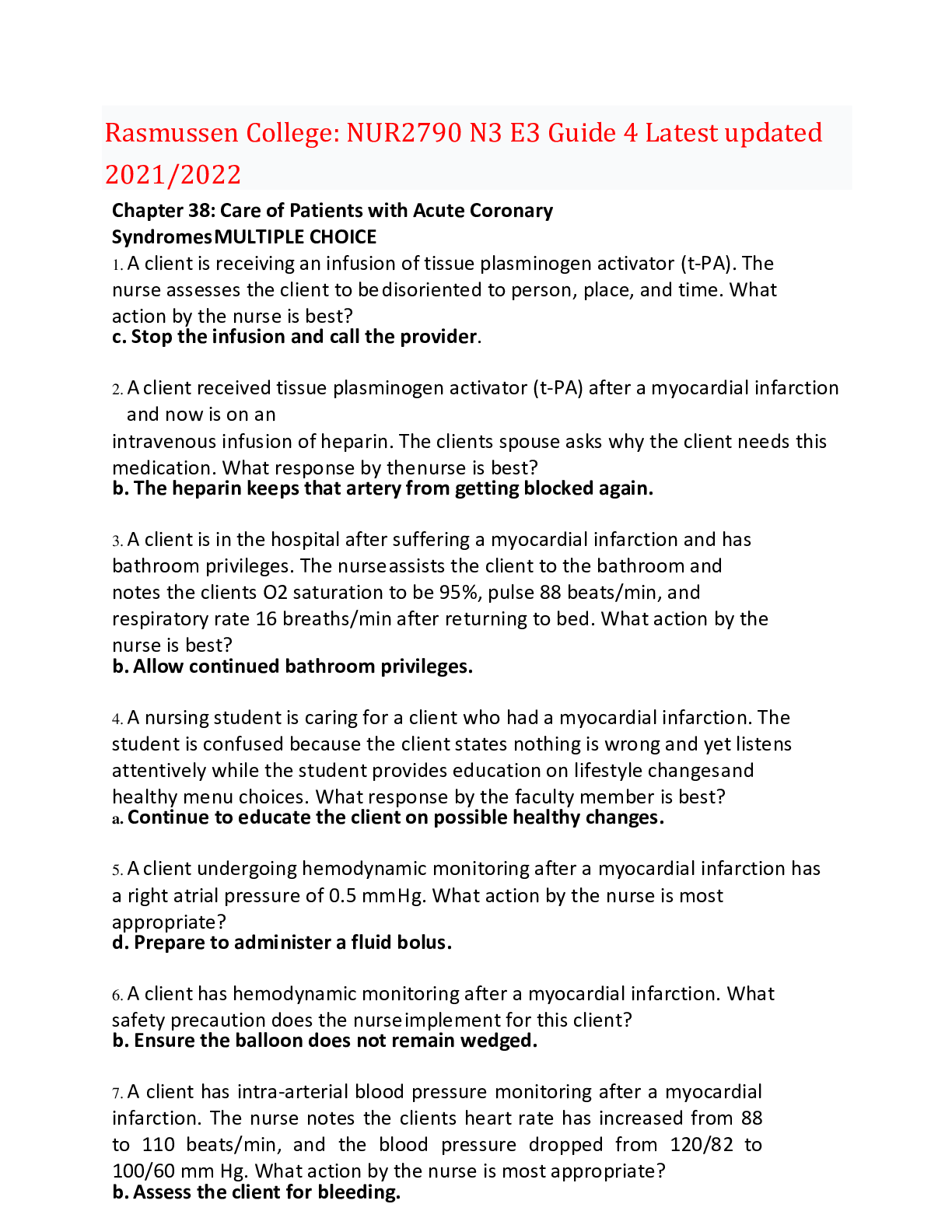


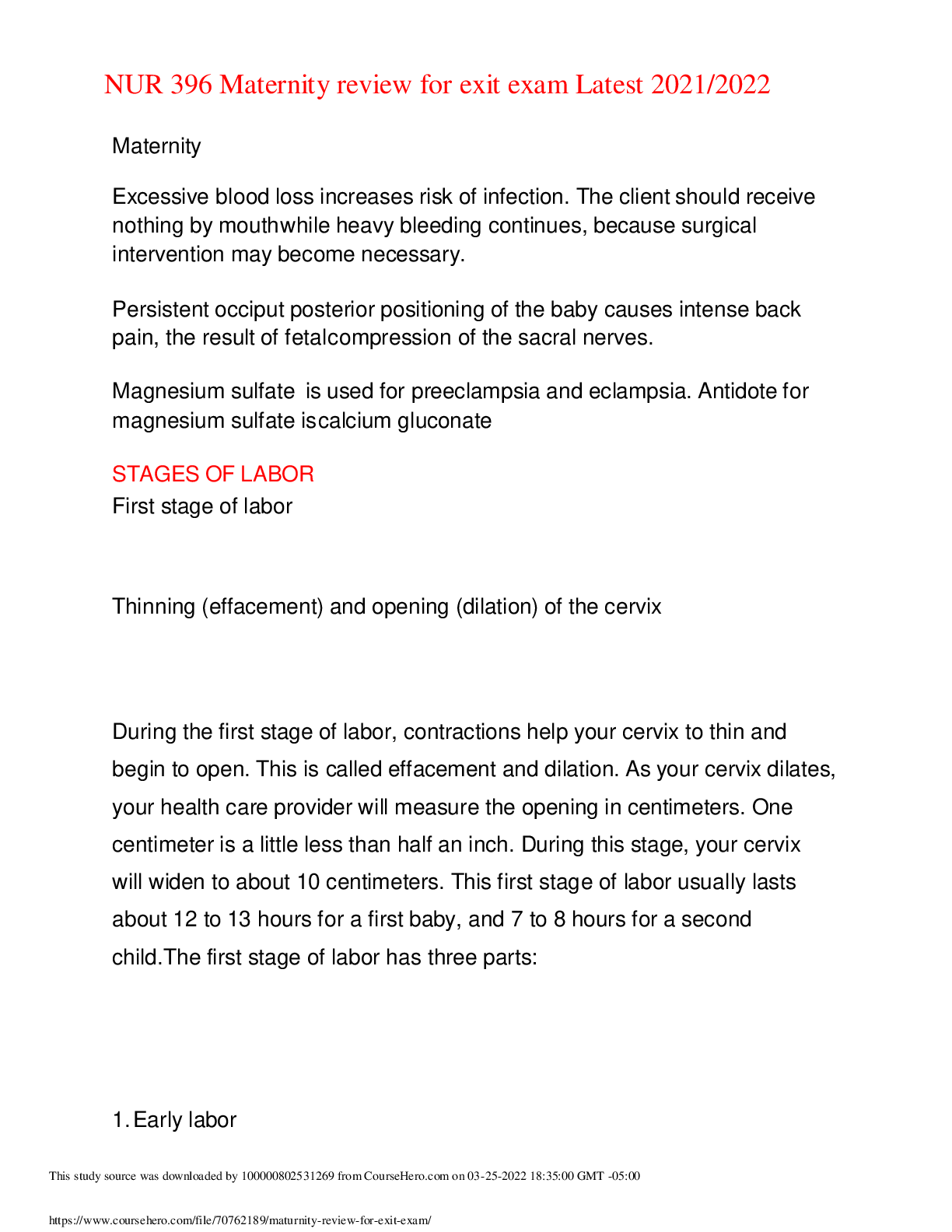

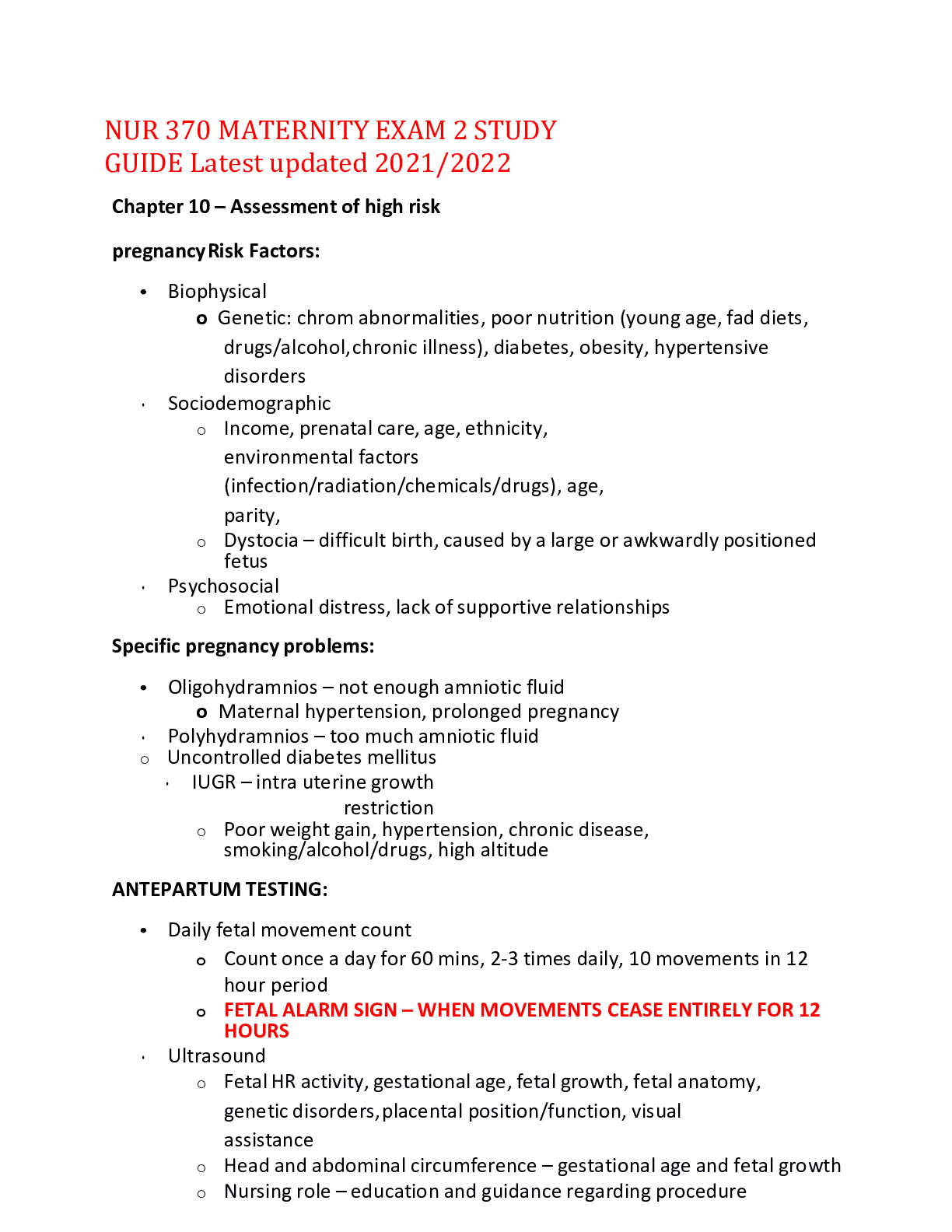

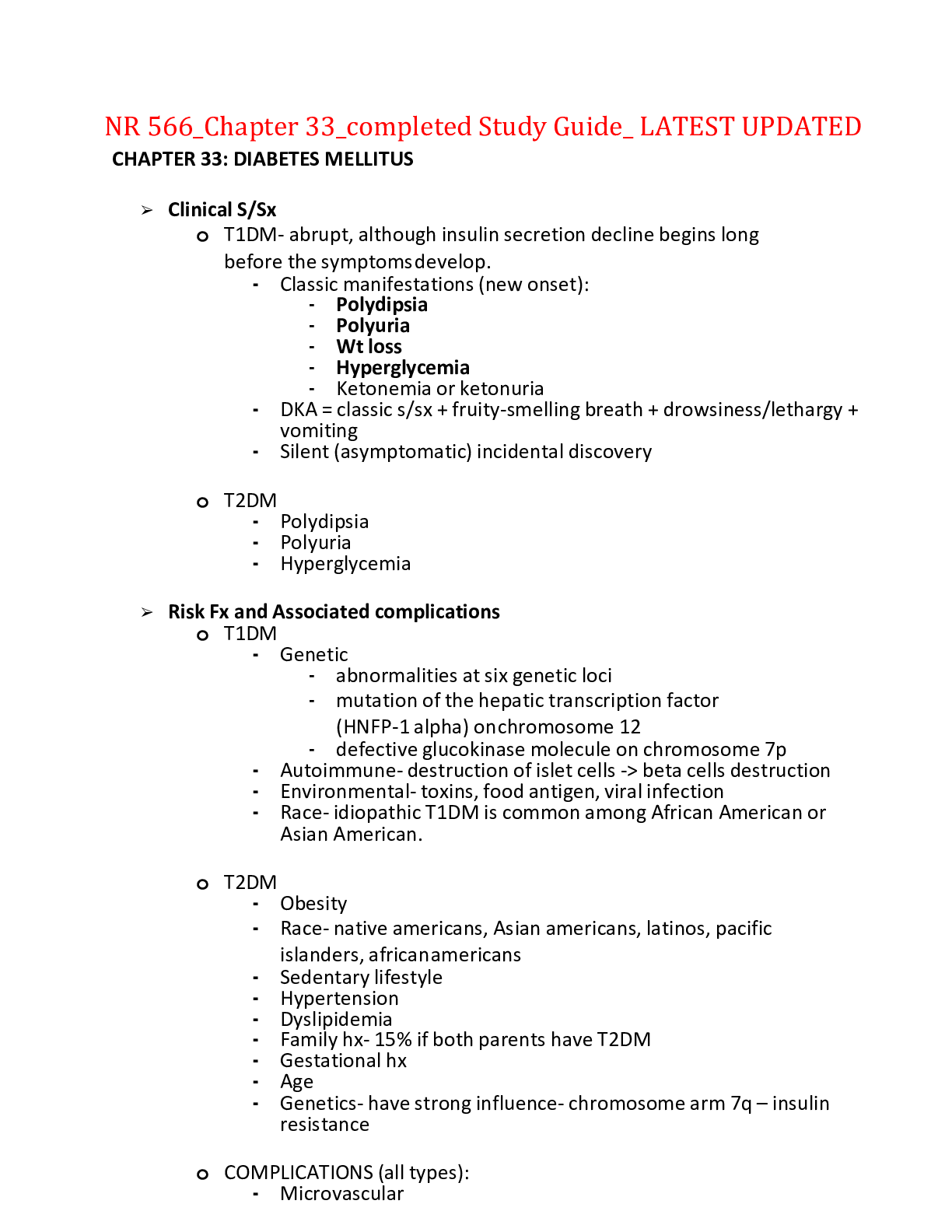
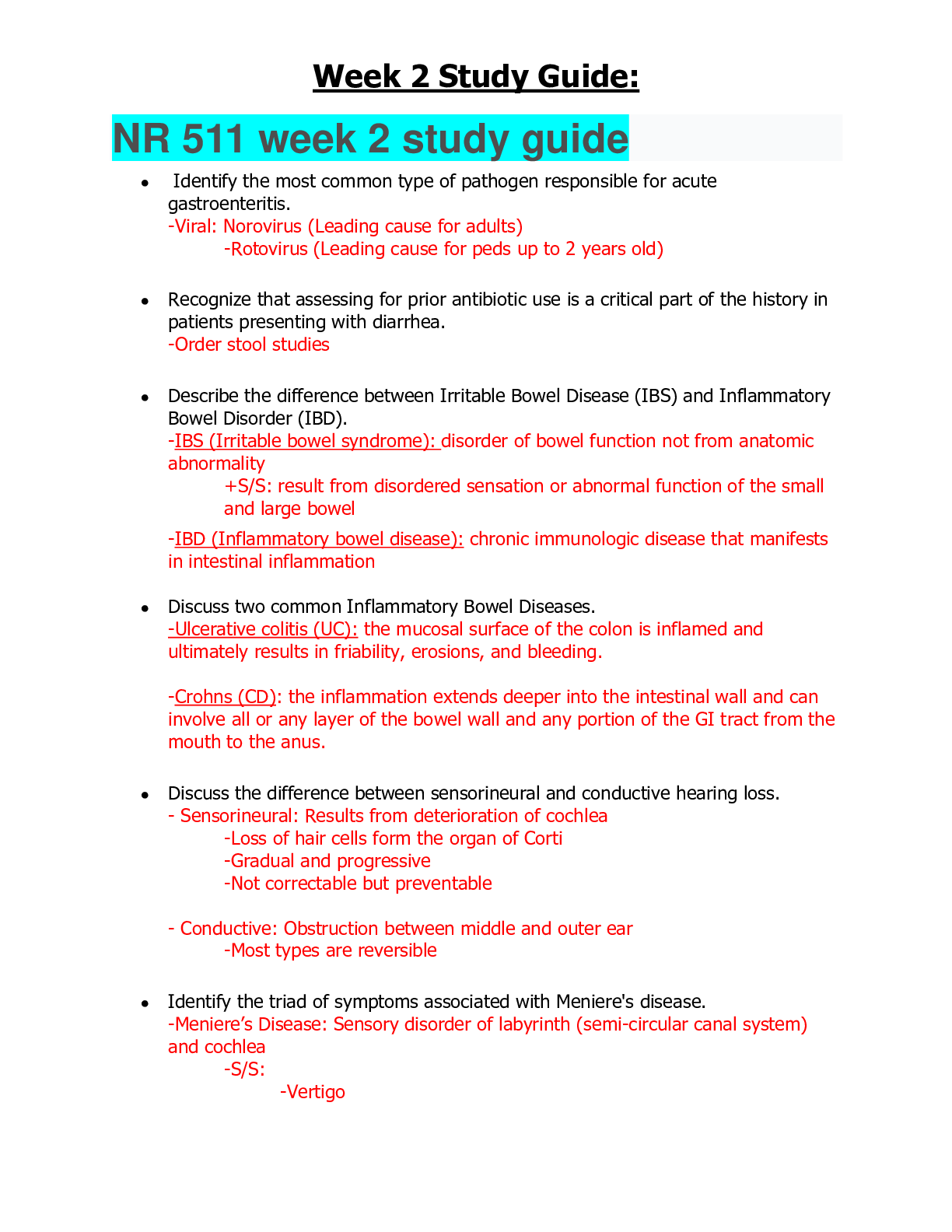
 qans.png)

.png)





